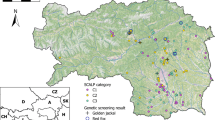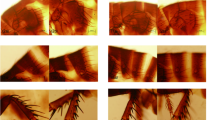Abstract
Self-biting disease occurred in most farmed fur animals in the world. The mechanism and rapid detection method of this disease has not been reported. We applied bulked sergeant analysis (BSA) in combination with RAPD method to analyze a molecular genetic marker linked with self-biting trait in mink group. The molecular marker was converted into sequence-characterized amplified regions (SCAR) marker for rapid detection of this disease. A single RAPD marker A8 amplified a specific band of 263bp in self-biting minks, which was designated as SRA8-250, and non-specific band of 315bp in both self-biting and healthy minks. The sequences of the bands exhibited 75% and 88% similarity to Canis familiarizes major histocompatibility complex (MHC) class II region and Macaca mulatta MHC class I region, respectively. A SCAR marker SCAR-A8 was designed for the specific fragment SRA8-250 and validated in 30 self-biting minks and 30 healthy minks. Positive amplification of SCAR-A8 was detected in 24 self-biting minks and 12 healthy minks. χ2 test showed significant difference (p<0.01) in the detection rate between the two groups. This indicated that SRA8-250 can be used as a positive marker to detect self-biting disease in minks. Furthermore, the finding that self-biting disease links with MHC genes has significant implications for the mechanism of the disease.
Similar content being viewed by others
References
Adam-Blondon AF, Sevignac M, Bannerot H, Dron M. 1994. SCAR, RAPD and RFLP markers linked to a dominant gene (Are) conferring resistance to anthracnose in common bean. Theor Appl Genet, 88: 865–870.
Affolter VK, Moore PF. 2002. Localised and disseminated histiocytic sarcoma of dendritic cell origin in dogs. Vet Pathol, 39: 74–83.
Agrama HA, Houssin SF, Tarek MA. 2002. Cloning of AFLP markers linked to resistance to Peronosclerospora sorghi in maize. Mol Genet Genomics, 267: 814–819.
Bautista R, Crespillo R, Canovas FM, Claros MG. 2003. Identification of olivetree cultivars with SCAR markers. Euphytica, 129: 33–41.
Bildsøe M, Heller KE, Jeppesen LL. 1990. Stereotypies in female ranch mink: seasonal and diurnal variations. Scientifur, 14(4): 243–247.
Day MJ. 1996. Expression of major histocompatability complex class II molecules by dermal inflammatory cells, epidermal Langerhans cells and keratinocytes in canine dermatological disease. J Comp Pathol, 115: 317–326.
De Bellis MD, Baum AS, Birmaher B, Keshavan MS, Eccard CH, Boring AM, Jenkins FJ, Ryan ND. 1999. Developmental traumatology Part I: Biological stress systems. Biol Psychiat, 45(10): 1259–1270.
De Bellis MD, Keshavan MS, Clark DB, Casey BJ, Giedd JN, Boring AM, Frustaci K, Ryan ND. 1999. Developmental traumatology Part II: Brain development. Biol Psychiat, 45(10): 1271–1284.
Delves PJ, Roitt IM. 2000. Advances in immunology: the immune system — parts 1 and 2. N Engl J Med, 343: 37–49, 108–117.
Doveren RF, Buurman WA, Schutte B, Groenewegen G, Van Der Linden CJ. 1985. Class II antigens on canine T lymphocytes. Tissue Antigens, 25: 255–265.
Goulao L, Cabrita L, Oliveira CM, Leitao JM. 2001. Comparing RAPD and AFLP analysis in discrimination and estimation of genetic similarities among apple (Malus domestica Borkh.) cultivars. Euphytica, 119: 259–270.
Hansen CPB. 1993. Stereotypes in ranch mink: the effect of gene, litter size and neighbors. Behav Process, 29: 165–178.
Hernandez P, Martin A, Dorado G., 1999. Development of SCARs by direct sequencing of RAPD products: A practical tool for the introgression and marker-assisted selection of wheat. Mol Breeding, 5: 245–253.
Jackson HA, Olivry T, Berget F, Dunston SM, Bonnefont C, Chabanne L. 2004. Immunopathology of vesicular cutaneous lupus erythematosus in the rough collie and Shetland sheepdog: a canine homologue of subacute cutaneous lupus erythematosus in humans. Vet Dermatol, 15: 230–239.
Jeppesen LL, Heller KE, Bildsoe M. 2004. Stereotypies in female farm mink (Mustela vison) may be genetically transmitted and associated with higher fertility due to effects on body weight. Appl Anim Behav Sci, 86(1): 137–143.
Kaundun SS, Matsumoto S. 2003. Development of CAPS markers based on three key genes of the phenylpropanoid pathway in tea, Camellia sinensis (L.) O. Kuntze, and differentiation between assamica and sinensis varieties. Theor Appl Genet, 106: 375–383.
Kiley M. 1977. Stereotypeies and their causation. Appl Anim Ethol, 3: 290–291.
Li YM, Yao JY, Ma LN, Li ZW, Bai XJ. 2008. RAPD genetic analysis on etiological factor of Mink self-biting disease. Chin J Biotech, 24(4): 563–568.
Lin N, Bai XJ. 2008. Cloning, sequencing and detecting exon polymorphism of Dopamine Receptor D2 gene in mink. J Econ Animal, 12(1): 13–17.
Mason GJ. 1993. Age and context affect the stereotypies of caged mink. Behaviour 127(3/4): 191–229.
Mason GJ. 1994. Tail-biting in mink (Mustela vison) is influenced by age at removal from the mother. Anim Welfare, 3: 305–311.
Marino M, Scuderi F, Mannella F, Bartoccioni E. 2003. TGF-β1 and IL-10 modulate IL-1b-induced membrane and soluble ICAM-1 inhuman myoblasts. J Neuroimmunol, 134: 151–157.
Matsumoto S, Fukui H. 1996. Identification of rose cultivars and clonal plants byrandom amplified polymorphic DNA. Sci Hort, 67: 49–54.
Mueller RS, West K, Bettenay SV. 2004. Immunohistochemical evaluation of mononuclear infiltrates in canine lupoid onychodystrophy. Vet Pathol, 41: 37–43.
Nevison CM, Hurst JL, Barnard CJ. 1999. Strain-specific effects of cage enrichment in male laboratory mice (Mus musculus). Anim Welfare, 8(4): 361–379.
Paran I, Michelmore RW. 1993. Development of Reliable PCR Based Markers Linked to Downy Mildew Resistance Genes in Lettuce, Theor Appl Genet, 85: 985–993.
Rajapakse S, Hubbard M, Kelly JW, Abbott AG, Ballard RE. 1992. Identification of rose cultivars by restriction fragment length polymorphism. Sci Hort, 52: 237–245.
Schore AN. 2002. Dysregulation of the right brain: A fundamental mechanism of traumatic attachment and the psychopatho genesis of posttraumatic stress disorder. Aust NZ J Psychiat, 36: 9–30.
Schoenecker B, Heller KE. 2000. Indication of a genetic basis of stereotypes in laboratory-bred bank voles (Clethrionomys glareolus). Appl Anim Behav Sci, 68(4): 339–347.
Siegel DJ. 1999. The developing mind: Toward a neurobiology of interpersonal experience. New York: Guilford Press.
Smith LB. 1984. Electric field therapy for equine stereotypic behaviors. J Biol Phys, 12: 33–36.
Sun DF, et al. 2006. The discussion on the relationship of self-biting behavior with lipid peroxidation of nerve cell in brain of fur carnivore. J Econ Animal, 10(4): 242–247.
Stemmer BL, Arlian LG, Morgan MS, Rapp CM, Moore PF. 1996. Characterization of antigen presenting cells and T-cells in progressing scabietic skin lesions. Vet Parasitol, 67: 247–258.
Stephen RW, Raymond TY, Warren RG, Robert HW, Ronald HA. 2001. Plasterk rapid gene mapping in Caenorhabditis elegans using a high density polymorphism map. Nat Genet, 28: 160–164.
Van Der Kolk BA. 1994. The behavioral and psychobiological effects of developmental trauma. In: A. Stoudemire (Ed.), Human behavior: An introduction for medical students (pp. 328–343). New York: Lippincott.
Wang ZL, Wang LX, Dai JR, Wang B, Li XZ. 2001. Molecular identification and mapping of a maize gene (Rf3) in S-type CMS using AFLP, RFLP and SCAR techniques. J Genet Genomics, 28: 464–470.
Zhang ZF, Wang Y, Zheng YL. 2006. AFLP and PCR-based markers linked to Rf3, a fertility restorer gene for S cytoplasmic male sterility in maize. Mol Genet Genomics, 276: 162–169.
Zhou CJ, Chen CX, Cao PX, Wu SW, Sun JW, Jin DM, Wang B. 2007. Characterization and fine mapping of RppQ, a resistance gene to southern corn rust in maize. Mol Genet Genomics, 278: 723–728.
Author information
Authors and Affiliations
Corresponding author
Rights and permissions
About this article
Cite this article
Liu, Zy., Ning, Fy., Yang, Hy. et al. Rapid detection of self-biting disease of mink by specific sequence-characterized amplified regions. Journal of Forestry Research 22, 123–126 (2011). https://doi.org/10.1007/s11676-011-0137-0
Received:
Accepted:
Published:
Issue Date:
DOI: https://doi.org/10.1007/s11676-011-0137-0




